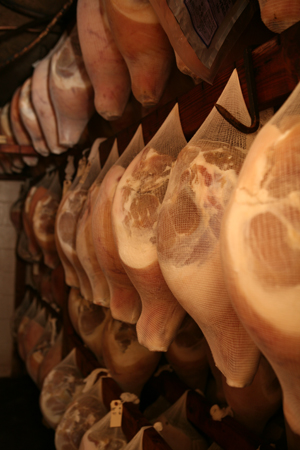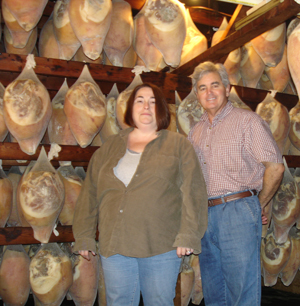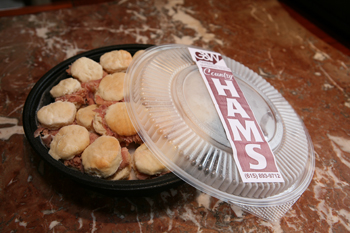If you were born and raised in the South, chances are you have been eating country ham your whole life. It’s as country as cornbread, grits and sweet tea. It’s a genuine, authentic part of Southern living and dining.
Right?
Well, maybe not. Chances are the ham your grandmother used to make wasn’t as traditional as you may have thought. In fact, most people’s grandmas have not been cooking authentic country hams the way they were customarily prepared in the region for years, says Bob Woods, owner and operator of G & W Hamery at 411 West Lytle Street.
Country hams get their name from the unique preservation process used to make them edible years after they have been cured. In the old days, Bob says, this was done by covering the hams in a mixture of salt and a little sugar and letting them rest for a couple of months during the winter. Afterward, the hams were washed and hung up, often in a smokehouse where they would dry out and shed water, compressing the meat’s distinct flavor into the smallest of morsels.
“For stores to legally market their product as ‘country ham,’ the meat must be cured and lose 17 percent of its original weight,” Bob explains. “Ours can lose twice that amount. I have gone looking for other places that make hams like we do, here and in the surrounding states, and I can’t find anyone who still does it quite like us.”
Bob can initially be a quiet man, taking a moment to ponder his words before he says them, and he carefully avoids bragging about the custom he is clearly proud to be maintaining.
“We’re doing things the old way, still traditionally,” says Jaymie Perry, the manager at G & W to whom the crew affectionately refers as JP. “A lot of people are interested in going back to the old way of eating, without artificial preservatives.”
In many ways, JP is the mascot for G & W, trumpeting the message of real, genuine country hams, and perhaps, Bob says, she’s just what the store needs.
“I met JP at the farmer’s market in Cannonsburgh three years ago,” Bob remembers with his trademark enigmatic smile. “She was sittin’ in the back of a pickup truck sellin’ turnip greens with a big blackberry in her hand. I told her that I had been lookin’ for a girl like her for years. That was the last day of the farmer’s market. She appeared here the next week.”
JP, though, remembers things a little differently. At the time, the hamery’s façade had changed very little from how it had looked when Bob’s grandfather erected the structure to serve as a veterinary hospital in 1950. In addition to blending in with an austere background of the parking lots and chain-link fences of the surrounding properties, the drab cinder-block building reminded JP of “a mental institution.”
“I told my husband that if I didn’t call him five minutes after I walked in to call the cops,” JP says, laughing.
Since JP arrived, the building has undergone a major renovation, but the process that happens inside hasn’t changed at all. Every year around Christmas, Bob, JP, the Hamery crew and an assortment of friends and family gather to salt more than 1,000 hams and pack them into the basement storage room that was once a series of stalls housing ailing horses and cattle. Every ham is covered in about two pounds of salt with a dash of sugar before being tightly arranged among the others. This salting process causes a reaction called salt equalization, which forces water out of the hams and prevents harmful microbes from growing.
“After being salted, country hams can last indefinitely,” Bob assures me while standing next to a three-year-old ham hanging in the smoke room. “In fact, a lot of old-timers say you shouldn’t eat a country ham until it has hung up for at least two years because as it loses its moisture, it gets more compact and the flavor becomes more intense.”
In 1968, Bob’s uncle, Sam Woods, and Sam’s cousin, Col. Tom Givon, cured eight hams in Givon’s garage and sold them out of the house. The next year, G & W was born, and the duo cured 50 hams. They quickly gained a reputation for their old-fashioned style, and success came easily.
“I suppose the first person who got a ham in ’68 told someone else it was good, and then they bought one and told someone else it was good,” Bob jokes, explaining why G & W became so popular with very little promotion.
JP is quick to offer more energetic enlightenment.
“There’s not a lot of shops like this,” she says, adding that there aren’t a lot of storeowners like Bob. When he steps out of earshot into the same office his grandfather once used, she describes Bob’s charitable work ethic.
“He is very attached to this place, very passionate about what he does. He wants the first ham he cures to be just as good as the last. Every time there is something going on with a school or kids, Bob donates and goes unnoticed . . . A lot of people do publicity stunts. Not Bob.”
Though Bob may try his best to fly under the radar, the Murfreesboro Fire Department has a habit of showing up every spring when he smokes his hams, despite the ham and biscuits and a friendly reminder he delivers to them the day before he lights up the old Ashley wood stove behind the hamery.
“They always show up saying someone called about the smoke,” Bob says as he chuckles slightly. “I think they just want some more biscuits.”
Whatever the case may be, G & W’s reputation is well earned, JP declares. Though they may be located in a small beige hole in the wall with a proprietor who prefers a quiet life rather than fame and recognition, the hamery’s customers know that what they buy there is the real deal.
G & W Hamery
411 W. Lytle St.
Whole Hanging Country Ham: $75, Fresh Sausage: $3.97/lb
Open Monday-Saturday, 10 a.m. – 4 p.m.
615-893-9712
thehamery.com

















I ttry to look at your catalgue but couldnt get it. Wanted to know if you could buy 1/2 ham? If not how much is whole hame deboned? thank you shirley
Comment October 5, 2011 @ 2:51 pm